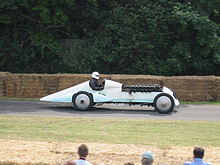Babs (land speed record car)
| Babs | |
|---|---|
 | |
| Overview | |
| Also called | Chitty Bang Bang 4, Higham Special |
| Production | one-off (1926) |
| Designer | J. G. Parry-Thomas, originally Clive Gallop & Count Louis Zborowski |
| Body and chassis | |
| Body style | open-wheel, front-engined racing car. |
| Powertrain | |
| Engine | Liberty L-12 V12 aero engine |
| Transmission | final drive by exposed external chain-drive |
Babs was the land speed record car built and driven by John Parry-Thomas. It was powered by a 27-litre Liberty aero-engine.
Babs began as 'Chitty 4', one of Count Louis Zborowski's series of aero-engined cars named 'Chitty Bang Bang'. As it was built at Zborowski's estate of Higham Park near Canterbury, it was also known as the Higham Special.
Using a 450 hp (340 kW) V12 Liberty aero engine of 27 litres capacity, with a gearbox and chain-drive from a pre-war Blitzen Benz, it was the largest capacity racing car ever to run at Brooklands. It was bodied by coach building firm Bligh Brothers. Still not fully developed by the time of Zborowski's death in 1924, it was purchased from his estate by J.G. Parry-Thomas for the sum of £125.[1]
Parry-Thomas rechristened the car Babs and rebuilt it with four Zenith carburettors and his own design of pistons.[2] In April 1926, Parry-Thomas used the car to break the land speed record at 171.02 mph (273.6 km/h).
Babs used exposed chains (covered by a fairing) to take power to the drive wheels. It has been rumored that the high engine cover required Parry-Thomas to drive with his head tilted to one side. This story is not true; photographs show that the driver could see straight ahead.
During a later record attempt at Pendine Sands, Wales on 3 March 1927, the car went out of control at speeds in excess of 100 mph. The car rolled over and Thomas was partially decapitated. Following the inquest into Thomas's death, Babs's seats were slashed, the glass in the dials smashed, and the car was buried in the sand dunes at Pendine.[3][4]
At the time it was thought that a drive chain had snapped, decapitating the driver. Later investigation of the recovered wreckage suggested, instead, that a failure of the rear right-hand wheel may have caused the accident.[5]
Restoration

In 1967 Owen Wyn Owen decided to excavate and restore Babs. The site of the burial was identified from old photographs, but it was found to be within the perimeter of the present-day rocket establishment. The military authorities granted permission for the excavation on condition that Parry-Thomas's next of kin did not object. It took Wyn Owen two years to locate a living relative, a nephew living in Walsall, and finally the wreck was recovered.[6] This recovery was controversial at the time, less so after the successful restoration. The prevailing opinion was that the wreck would be unsalvageable for anything more than a pitiful museum display. Few expected that the wreck would ever resemble a car again, let alone be restored to running order.
The car was in very poor condition. Much of the bodywork had corroded, so a new body had to be constructed, melding in where possible any existing original material. The mechanical running gear though was in good condition. Even where components could not be used, they were sufficiently preserved to act as a pattern. The engine was salvageable, but many new replacement parts had to be made from original designs.[citation needed]
The car was first successfully tested on The Helyg straight in the early 1970s. The test consisted of being towed by the local garage owner's Land Rover (Dafydd Hughes and his mechanic Allan Hughes), to 60 miles per hour (97 km/h) and then Babs was bump started. The gearing was so high that being towed was the only way to get Babs moving under its own power. The car was later successfully demonstrated in front of the world press and television on an airfield near RAF Valley, Anglesey.
The restoration work took place in Owen's garage in Capel Curig, and Babs was displayed in the Pendine Museum of Speed during the summer months until its demolition in February 2021. The new museum building was completed in early 2023 and opened on 31 March.[7][8][9][10] The car was run at the Brooklands Centenary in 2007.
In 1999, Owen was awarded the Tom Pryce trophy,[11] engraved with the words Atgyfodwr Babs ('Resurrector of Babs'). Following Owen's death in 2012, the car is driven by his son Geraint.[4]
References
- ^ "Higham Special". British Motor Manufacturers. Archived from the original on 7 February 2012.
- ^ Jo Payne (2004). "Thomas, John Godfrey Parry (1884–1927)". Oxford Dictionary of National Biography, Oxford University Press. doi:10.1093/ref:odnb/69166. Retrieved 9 September 2006.
- ^ "Wales and the History of the World – 'Babs'". BBC. Retrieved 30 December 2011.
- ^ a b "Southern Wales". Coast: The Great Guide. Episode 2. 28 September 2016. BBC. Retrieved 28 September 2016.
- ^ Tremayne, David. The Land Speed Record. Shire. p. 9. ISBN 0-7478-0115-0.
- ^ "Wales: Old girl with a racy past". The Daily Telegraph. 12 August 2000. Retrieved 2 March 2013.
- ^ "Pendine Tourism Attractor project opens in time for Easter". Western Telegraph. 5 April 2023.
- ^ "History of Pendine". Archived from the original on 9 September 2010.
- ^ "Babs being recovered from the sand, showing the missing fatal drive chain". Archived from the original (photograph) on 19 February 2017. Retrieved 7 May 2008.
- ^ "Remaining drive chain on the left-hand side". Archived from the original (photograph) on 22 December 2005. Retrieved 7 May 2008.
- ^ "About us Amdanom Ni". Welsh Group of Motoring Writers. Retrieved 2 March 2013.
